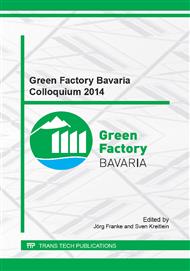[1]
G. Brauner, W. D'Haeseleer, W. Gehrer, W. Glaunsinger, T. Krause, H. Kaul , M. Kleinmaier, W. Kling, H. M. Prasser, I. Pyc, W. Schröppel, W. Skomudek, Electrical Power Vision 2040 for Europe. EUREL - Convention of National Associations of Electrical Engineering of Europe, 2013. http: /www. eurel. org/home/taskforces/documents/eurel-pv2040-short_version_web. pdf.
DOI: 10.1007/s00502-013-0128-2
Google Scholar
[2]
P. Waide, C.U. Brunner, Energy-efficiency policy opportunities for electric motor-driven systems. OECD Publishing, 2011. http: /www. iea. org/publications/freepublications/publication/EE_for_ElectricSystems. pdf.
Google Scholar
[3]
K. Bunse, M. Vodicka, P. Schönsleben, M. Brülhart, F.O. Ernst, Integrating energy efficiency performance in production management – gap analysis between industrial needs and scientific literature. Journal of Cleaner Production 19 (2011) 667–679.
DOI: 10.1016/j.jclepro.2010.11.011
Google Scholar
[4]
W. Kahlenborn, S. Kabisch, J. Klein, I. Richter, S. Schürmann, Energiemanagementsysteme in der Praxis: ISO 50001: Leitfaden für Unternehmen und Organisationen, (2012).
Google Scholar
[5]
R. Steinhilper, S. Freiberger, J. Böhner, Green Factory Bavaria Standort Bayreuth: Sachbericht zum 30. 06. 2014, Fraunhofer IPA, (2014).
Google Scholar
[6]
M. Frauenhofer, S. Kreling, H. Kunz, K. Dilger, Green Production of CFRP Parts by Application of Inductive Heating, in: Hesselbach, J., Herrmann, C. (Eds. ), Glocalized Solutions for Sustainability in Manufacturing. Springer Berlin, Heidelberg, (2011).
DOI: 10.1007/978-3-642-19692-8_69
Google Scholar
[7]
T. Suzuki, J. Takahashi (Eds. ), Prediction of energy intensity of carbon fiber reinforced plastics for mass-produced passenger cars, (2005).
Google Scholar
[8]
R. Lässig, M. Eisenhut, A. Mathias, R. Schulte, F. Peters, T. Kühmann, T. Waldmann, W. Begemann, Serienproduktion von hochfesten Faserverbundbauteilen: Perspektiven für den deutschen Maschinen- und Anlagenbau, (2012).
Google Scholar
[9]
I. Viļumsone-Nemes, Automated cutting of textile materials, in: Industrial Cutting of Textile Materials, Elsevier, (2012) 104–127.
DOI: 10.1533/9780857095565.104
Google Scholar
[10]
S. Kara, G. Bogdanski, W. Li, Electricity Metering and Monitoring in Manufacturing Systems, in: J. Hesselbach, C. Herrmann (Eds. ), Globalized Solutions for Sustainability in Manufacturing. Springer Berlin, Heidelberg, (2011) 1–10.
DOI: 10.1007/978-3-642-19692-8_1
Google Scholar
[11]
J. Böhner, Ein Beitrag zur Energieeffizienzsteigerung in der Stückgutproduktion. Shaker, Aachen, (2013).
Google Scholar
[12]
R. Saidur, A review on electrical motors energy use and energy savings. Renewable and Sustainable Energy Reviews 14 (3) (2010) 877–898.
DOI: 10.1016/j.rser.2009.10.018
Google Scholar
[13]
Deutsches Institut für Normung e.V. DIN EN 60034-1 (VDE 0530-1): 2011-02 - Drehende elektrische Maschinen Teil 1: Bemessung und Betriebsverhalten.
Google Scholar
[14]
J. R. Duflou, J. W. Sutherland, D. Dornfeld, C. Herrmann, J. Jeswiet, S. Kara, M. Hauschild, K. Kellens, Towards energy and resource efficient manufacturing: A processes and systems approach. CIRP Annals-Manufacturing Technology 61 (2) (2012).
DOI: 10.1016/j.cirp.2012.05.002
Google Scholar


